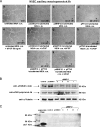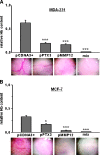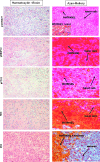Systemic sclerosis-endothelial cell antiangiogenic pentraxin 3 and matrix metalloprotease 12 control human breast cancer tumor vascularization and development in mice
- PMID: 19794969
- PMCID: PMC2745676
- DOI: 10.1593/neo.09934
Systemic sclerosis-endothelial cell antiangiogenic pentraxin 3 and matrix metalloprotease 12 control human breast cancer tumor vascularization and development in mice
Abstract
We have previously shown that endothelial cell matrix metalloprotease 12 (MMP12) and pentraxin 3 (PTX3) overproduction is the main alteration accounting for reduced proneness to angiogenesis in systemic sclerosis (SSc). On this basis, we stably transfected MMP12 and PTX3 in two breast cancer cell lines expressing very low amounts of the target molecules when compared with normal breast epithelial cells, relying on the hypothesis that antiangiogenic molecules released by cancer cells could confer an SSc-like antiangiogenic pattern on target endothelial cells. In Matrigel Boyden chamber invasion and capillary morphogenesis studies, transfected clones reduced endothelial cell invasion and capillary tube formation, which were abolished by tumor cell populations expressing both molecules. The Matrigel sponge assay, performed in vivo in C57/BL6 mice by injecting aliquots of lyophilized culture medium of transfected clones, indicated a similar reduction in angiogenesis. Functional studies have shown that endothelial cells treated with a culture medium of MMP12-expressing clones underwent cleavage of urokinase-type plasminogen activator receptor domain 1 which is indispensable to angiogenesis. We did not observe angiostatin production from plasminogen under the same experimental conditions. PTX3-overexpressing clones showed a powerful anti-fibroblast growth factor 2 (FGF2) activity in FGF2-dependent capillary morphogenesis. We have injected control and transfected clones into nude nu/nu (CD-1) BR mice to study the differential tumor growth pattern. We observed a reduction of tumor growth in transfected clones, which was basically complete when clones expressing both molecules were simultaneously injected. The extent of tumor necrosis suggested an antiangiogenesis-dependent inhibition of tumor development.
Figures







Similar articles
-
Modulation of the angiogenic phenotype of normal and systemic sclerosis endothelial cells by gain-loss of function of pentraxin 3 and matrix metalloproteinase 12.Arthritis Rheum. 2010 Aug;62(8):2488-98. doi: 10.1002/art.27522. Arthritis Rheum. 2010. PMID: 20506099
-
Long pentraxin 3/tumor necrosis factor-stimulated gene-6 interaction: a biological rheostat for fibroblast growth factor 2-mediated angiogenesis.Arterioscler Thromb Vasc Biol. 2012 Mar;32(3):696-703. doi: 10.1161/ATVBAHA.111.243998. Epub 2012 Jan 19. Arterioscler Thromb Vasc Biol. 2012. PMID: 22267482 Free PMC article.
-
Pentraxin 3 (PTX3) inhibits plasma cell/stromal cell cross-talk in the bone marrow of multiple myeloma patients.J Pathol. 2013 Jan;229(1):87-98. doi: 10.1002/path.4081. Epub 2012 Oct 1. J Pathol. 2013. PMID: 22847671
-
Anti-FGF2 approaches as a strategy to compensate resistance to anti-VEGF therapy: long-pentraxin 3 as a novel antiangiogenic FGF2-antagonist.Eur Cytokine Netw. 2009 Dec;20(4):225-34. doi: 10.1684/ecn.2009.0175. Eur Cytokine Netw. 2009. PMID: 20167562 Review.
-
Pentraxin-3 and endothelial dysfunction.Adv Clin Chem. 2019;91:163-179. doi: 10.1016/bs.acc.2019.03.005. Epub 2019 May 4. Adv Clin Chem. 2019. PMID: 31331488 Review.
Cited by
-
Cytokine TNF-α promotes invasion and metastasis of gastric cancer by down-regulating Pentraxin3.J Cancer. 2020 Jan 17;11(7):1800-1807. doi: 10.7150/jca.39562. eCollection 2020. J Cancer. 2020. PMID: 32194791 Free PMC article.
-
Impaired coronary collateral growth in the metabolic syndrome is in part mediated by matrix metalloproteinase 12-dependent production of endostatin and angiostatin.Arterioscler Thromb Vasc Biol. 2013 Jun;33(6):1339-49. doi: 10.1161/ATVBAHA.113.301533. Epub 2013 Apr 18. Arterioscler Thromb Vasc Biol. 2013. PMID: 23599440 Free PMC article.
-
The War on Cancer rages on.Neoplasia. 2009 Dec;11(12):1252-63. doi: 10.1593/neo.91866. Neoplasia. 2009. PMID: 20019833 Free PMC article.
-
Isolation and characterization of adult mammary stem cells from breast cancer-adjacent tissues.Oncol Lett. 2017 Sep;14(3):2894-2902. doi: 10.3892/ol.2017.6485. Epub 2017 Jun 28. Oncol Lett. 2017. PMID: 28927044 Free PMC article.
-
Inhibitory Role of Pentraxin-3 in Esophageal Squamous Cell Carcinoma.Chin Med J (Engl). 2016 Sep 20;129(18):2233-40. doi: 10.4103/0366-6999.189921. Chin Med J (Engl). 2016. PMID: 27625097 Free PMC article.
References
-
- Wittekind C, Neid M. Cancer invasion and metastasis. Oncology. 2005;69:14–16. - PubMed
-
- Carmeliet P, Collen D. Transgenic mouse models in angiogenesis and cardiovascular disease. J Pathol. 2000;190:387–405. - PubMed
-
- Ferrara N. VEGF: an update on biological and therapeutic aspects. Curr Opin Biotechnol. 2000;11:617–624. - PubMed
-
- Maxwell PH. The HIF pathway in cancer (2005) Semin Cell Dev Biol. 2005;16:523–530. - PubMed
-
- Cutolo M, Grassi W, Matucci-Cerinic M. Raynaud's phenomenon and the role of capillaroscopy. Arthritis Rheum. 2003;48:3023–3030. - PubMed
Publication types
MeSH terms
Substances
LinkOut - more resources
Full Text Sources
Other Literature Sources
Research Materials
Miscellaneous
